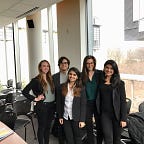Co-Design with our Client
Bringing Eaton into our Design Process
This week, Team Eaton conducted another co-design session (check out our first one in Puerto Rico!)- this time with our clients. Using “Scenes” from SAP, we created 3D storytelling tools to envision scenarios based upon our four most recent hunt statements, in the form of “how-might-we” questions:
1. How might we identify affected communities after a disaster to help first responders reach them faster?
2. How might we provide reliable, non-power dependent communication to civilians so that they can reach out directly to first responders?
3. How might we facilitate information flow between first responders and utility companies?
4. How might we provide reliable, non-power dependent communication to civilians so that they can communicate after a disaster?
Designing the Workshop
We set the stage with different representations of people, places, Eaton products, and blank materials to draw connections and tell stories. Using simple cut-outs and paper clips proved to be extremely helpful in ideation — once we told one possible story, it was easy to build on each other’s ideas.
The Value of Paper Tools
There is so much value in using low-fidelity paper tools. It’s easy to quickly write down notes and other information on the pieces (for example, labeling a truck with “FEMA”), and it’s quick to set up. One interesting thing we noticed was that the number of products you give participants is a form of constraining design ideas or nudging them in a certain direction. We printed and cut out LOTS of drones, of all sizes, which looked like a little army on the table — our clients noted that we obviously liked ideas involving drones.
Co-Design is Fun!
The co-design activity is another fantastic way to get everyone’s ideas on the table — it’s very active, and when facilitated well, gets everyone involved. There is a lot of “yes, and” happening in the room — our session was very generative.
Four Design Solutions
After we created four stories — one for each hunt statement — we shared them with each other and talked about what worked and what didn’t. In doing this, we realized that many of our solutions could be combined. We are lucky to be working in a project that allows for long-term, more future-thinking solutions that might not be implemented for 5–10 years.
Altruistic Manpower: In this design, Eaton identifies a vulnerable community nearby to Eaton manufacturing facilities that will be helped with Eaton employee volunteers after a natural disaster. Eaton will also share some of their resources, such as trucks and trailers, with first-responders after their facilities are back up and running.
Drone Mailperson: Smart street lights are installed in a city, allowing for civilians to connect to wifi through a mesh network system. When a disaster strikes and internet access is cut off, the mesh network persists as a local network with a basic emergency contact application. Civilians fill out personal info on the application. A rescue drone flies near the mesh network to collect the database of emergency contacts, to inform the outside world on the otherwise cutoff city inhabitants.
Utility-Responder Bi-directionality: In this design, utility companies and first responders share information with each other as they collect data on a post-disaster situation.
Peer2Peer Situation: Small smart modules are connected to power lines, and transmit data to the Eaton cloud. Data from these modules is used to create a visualization of overall grid status. When a storm comes and destroys parts of the grid, the change is reflected in the visualization. Modules that no longer transmit data indicate where significant damage has occurred.
Ranking Our Designs
We created a Pugh Chart after creating our scenarios, and worked together to come up with design criteria. We then ranked each design against the criteria, which then allowed us to score each design. The most enthusiasm surrounded the drone mailperson idea (not surprising to us!), but it was a very useful exercise to think about what we value most in a design idea, and using a ranking system to determine the best idea against these criteria. We found criteria like “dope-ness” and “MVP-able” to actually be incredibly useful — these are important features in a design solution for us, and for our client.
Moving Forward
We have now determined which design ideas we will move forward with, and what our hunt statement for the project should be. The mission statement for our project:
How might we leverage IoT devices and utility company resources to facilitate information flow between vulnerable communities and first responders?
Stay tuned for how we’re using this statement to refine design solutions!
